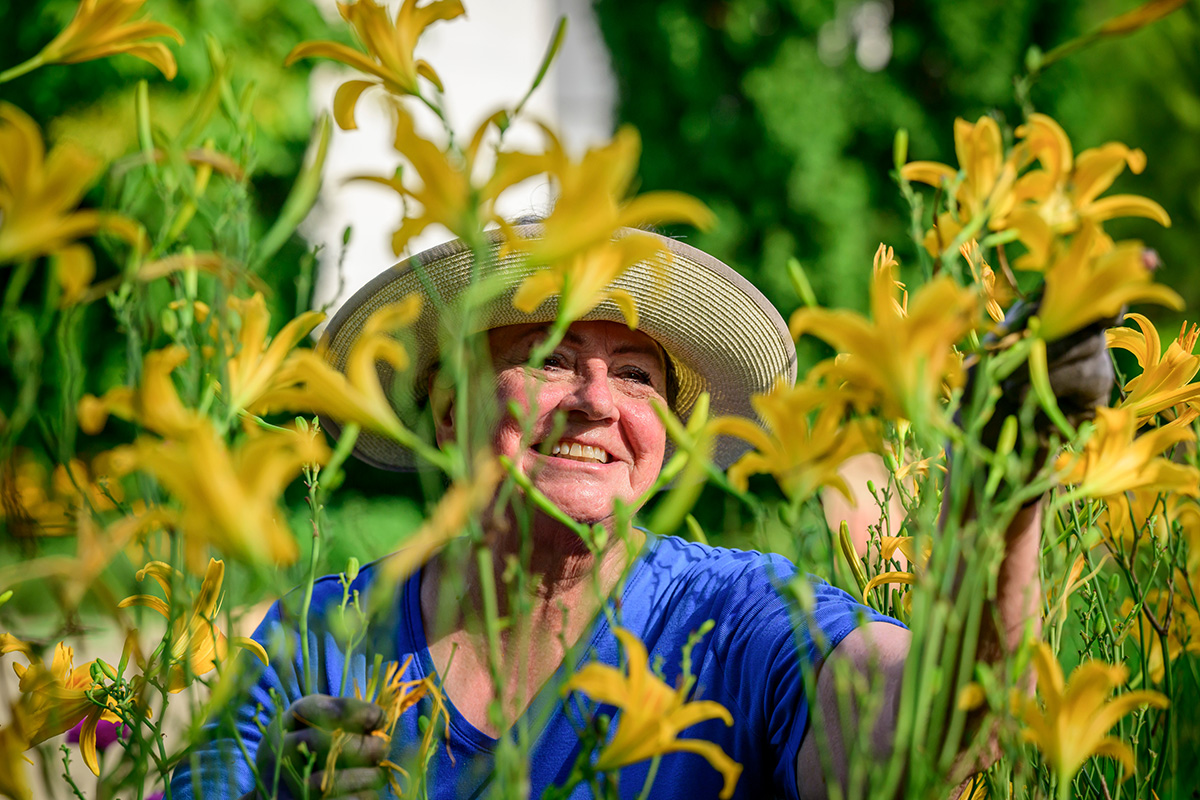
The splendor of Gelvin Gardens outside of Krannert Art Museum is a reflection of the original landscape design and the dedication of a group of volunteer gardeners. Even on a sweltering hot day, gardener Mary Beth Kurasek says the work is relaxing, a common theme for many of the volunteers. Led by Master Gardener Gloria Rainer, the volunteers gather to weed, prune, plant and feed the plants to keep them looking their best throughout the growing season.
Photo by Fred Zwicky
CHAMPAIGN, Ill. - It's one of the hottest days of the summer, but a dozen people have gathered with their water bottles, sun hats and gardening tools in front of Krannert Art Museum at the University of Illinois Urbana-Champaign. They're starting early in the morning, before it gets even hotter, amid blooms of pink, purple, yellow, orange and white. They're clipping the spent flowers from zinnias and the dead leaves from day lilies, weeding and watering.
These volunteers keep the Gelvin Gardens at the museum's entrance looking beautiful. KAM director Jon Seydl calls the gardens the "first and last gallery" of the museum "because they not only house works from the collection but also because the gardens are a work of art in and of themselves."
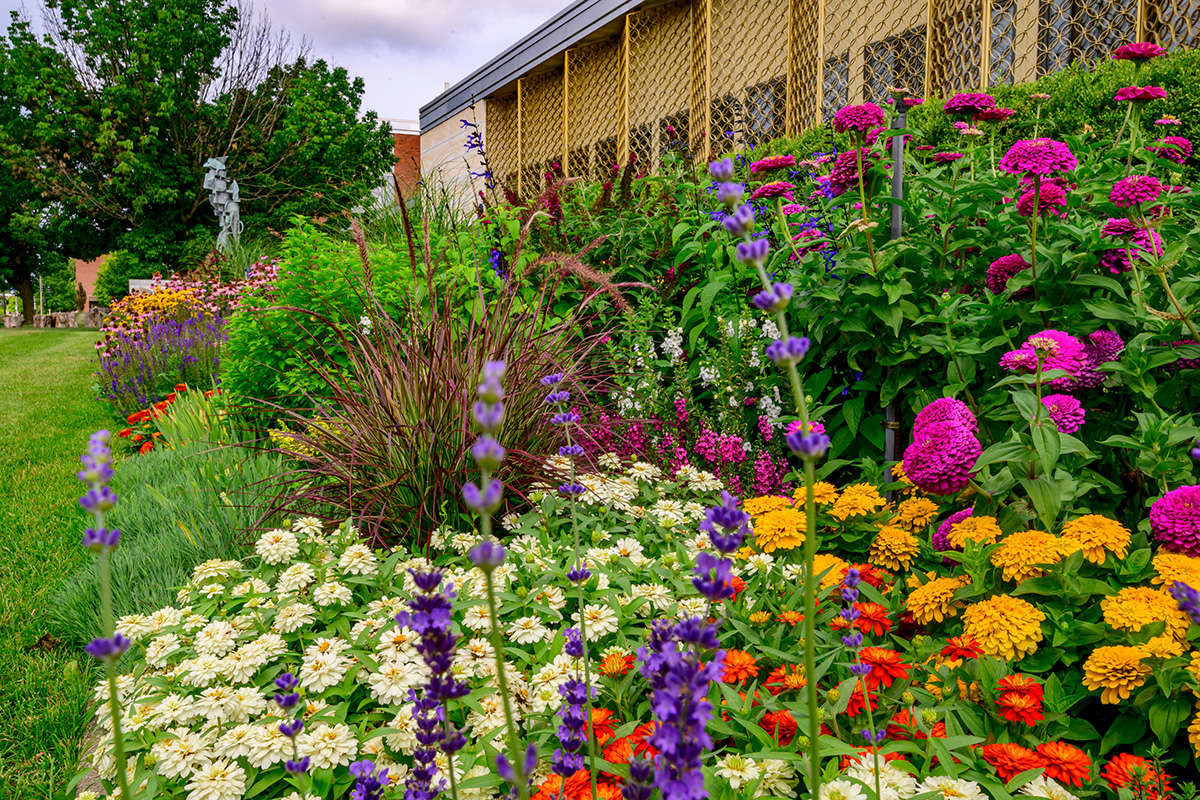
The flowers reached their peak beauty during late July this year. However, the garden is designed to have continuous color from different flowers throughout the growing season. The zinnia varieties include Zahara, Magellan and Benary's Giant zinnias.
Photo by Fred Zwicky
"All the gardeners believe the way we present the plant material in this garden serves as living sculpture," says Gloria Rainer, a Master Gardener who has worked in the gardens for 13 years and oversees the volunteers.
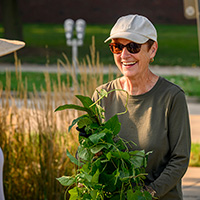
Master Gardener Gloria Rainer, right, chats with Leslie Arvan as she checks in on the plan for garden care for this day.
Photo by Fred Zwicky
Gelvin Gardens, which also contain several Tom Otterness sculptures, were dedicated in 1990 after Roseann Gelvin Noel and Philip Gelvin donated funds for the gardens to honor their parents, H.I. and Mabery Gelvin. Landscape architecture professor emeritus Terry Harkness designed the gardens. Rainer and other volunteers took over the maintenance to provide regular upkeep.
"It was daunting. Weeds had taken over that garden. We removed 198 big garden trash bags packed with weeds. It took three years before we really felt we had it under control," Rainer tells me as we tour the gardens.
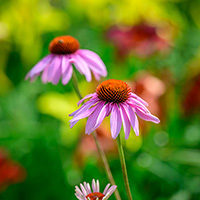
The Gelvin Gardens provide an oasis of natural beauty, including these Echinachea, or purple coneflowers.
Photo by Fred Zwicky
The gardens have perennials, but the volunteers plant annuals each year to provide continuous color throughout the season. They planted 500 annuals this past spring.
About 20 volunteers care for the gardens, with 12-15 showing up to work every Thursday morning from March through mid-November. Rainer prioritizes the jobs that need to be done each week. They do a garden clean-up in the early spring and then the "big dig" in mid-May when they plant. They mulch, prune, dead head, cut back certain plants and remove others that aren't thriving. The weeding and watering are constant.
"It looks the way it looks because of the commitment and faithfulness of the volunteers," Rainer says.
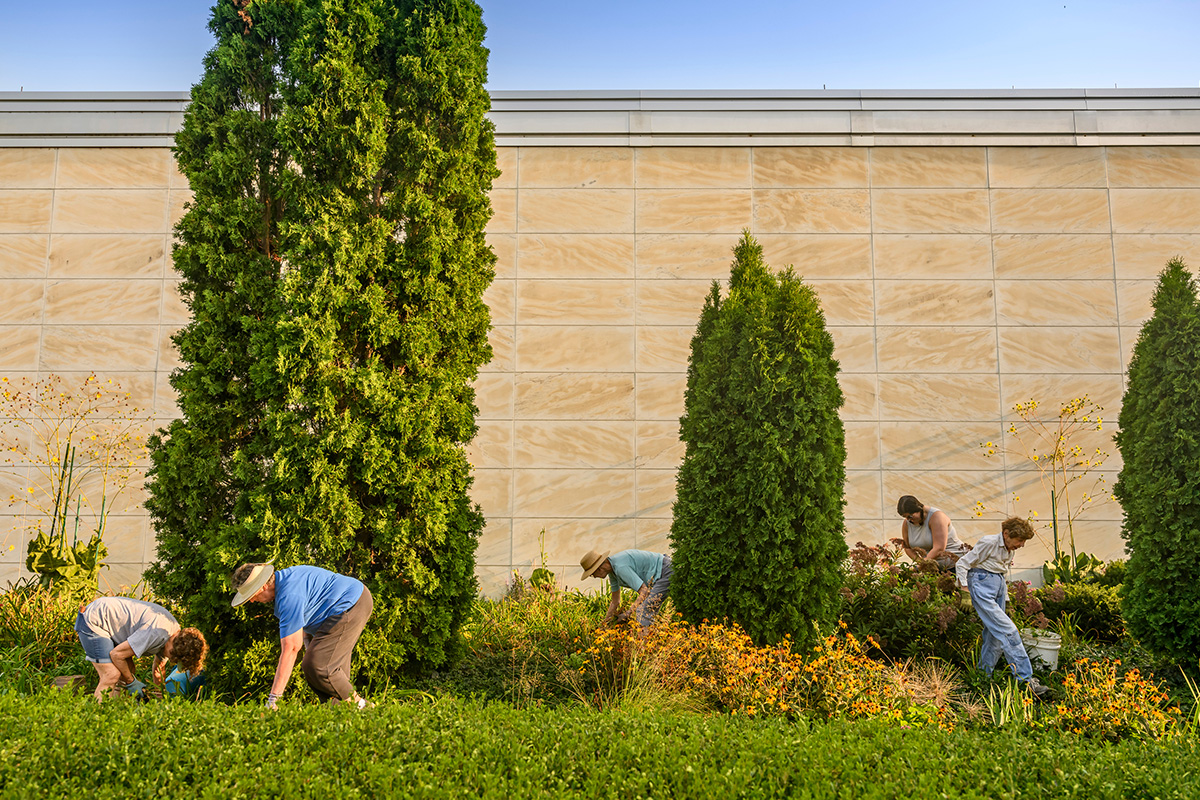
The care of the gardens is a team effort. Gloria Rainer knows the preferences of the volunteers and what parts of the garden each one likes to work in.
Photo by Fred Zwicky
Seydl says that in addition to the annuals planted each year, Rainer has added more evergreens and plants that hold their shape during the winter, and more texture and variety in plant material to increase the interest of the gardens year-round.
Rainer also provided a stunning site for visitors when the museum was closed during the pandemic, he says.
"I really admire Gloria's fortitude and organization, especially how she really marshalled the group around the mission of providing a meaningful outdoor opportunity during the pandemic as well as the need for community among the gardeners," Seydl says.
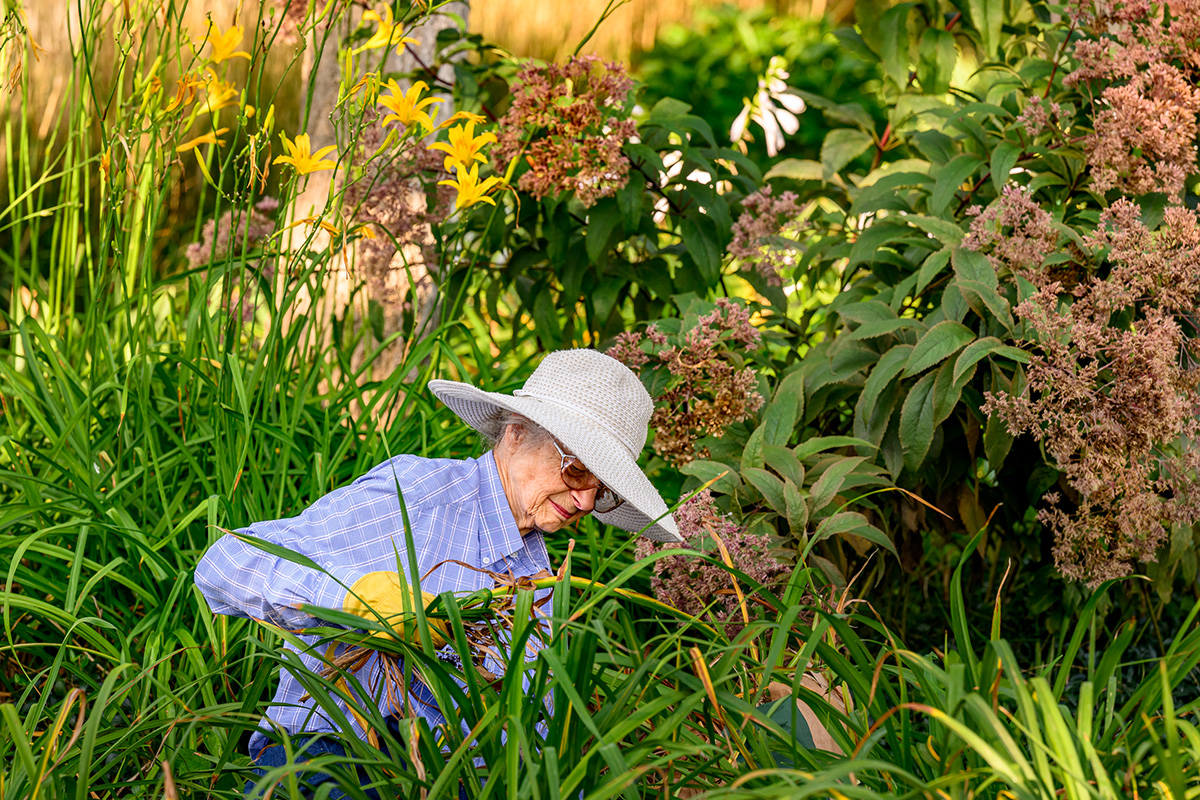
Volunteer Mary Elliott methodically pulls weeds and dead leaves as she works through a section of the Gelvin Gardens.
Photo by Fred Zwicky
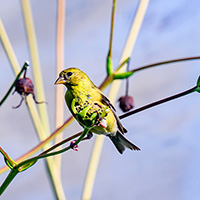
A goldfinch feeds on seeds as it roosts in the yellow flowers of prairie dock in the garden.
Photo by Fred Zwicky
As the volunteers work, they chat with each other, enjoying the social component of the work as much as the gardening itself. Three women are working next to the museum, pulling weeds and dead leaves. Volunteer Debbie Day holds up a handful of blue spiderwort plants that she has yanked from the ground.
"It has a beautiful blue flower, but it's invasive," she says.
Katelyn Talbott is the youngest volunteer in the group.
"It's like gardening with my mom," she says, after pointing out a hummingbird darting around the flowers. "I learn so much every week, and then I'll go home and do this in my own garden."
Day tells her: "Don't put these pretty blue things in your garden!"
The group pauses for a photo, but some volunteers still have their eyes on the gardens. Jane Myers points out a goldfinch on the yellow flowers of prairie dock growing 7 feet tall next to the museum.
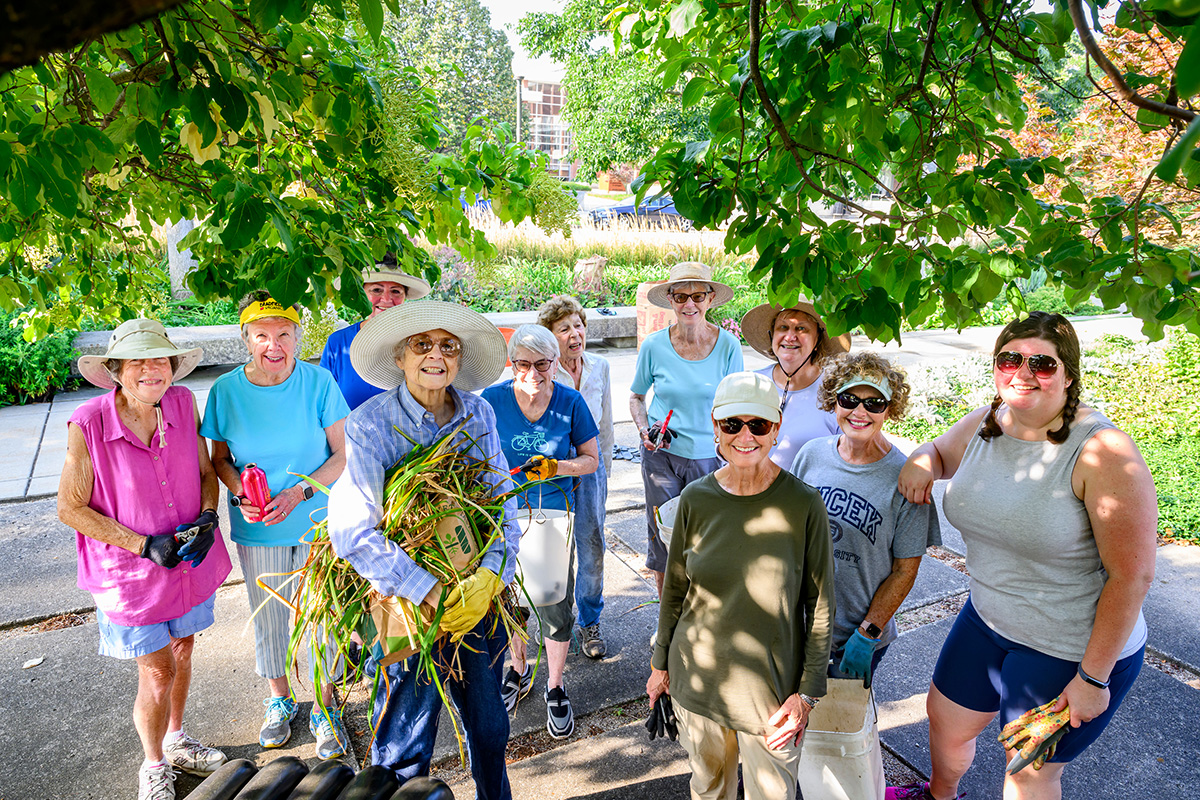
Despite the heat, this group of Gelvin Garden volunteers is undeterred as they care for the gardens that grace the front entrance of the Krannert Art Museum.
Photo by Fred Zwicky
"It's a native prairie plant. The leaves are very, very rough and the roots go 12-15 feet deep," Myers says. "I'd like to get compass plants. It's kind of the same. The roots go real deep, and its blooms turn toward the sun."
The gardeners are always experimenting and learning new things, Rainer says. She points out begonias that are doing well in the sun, even though the plant usually likes the shade. These look better than those planted in shade nearby - maybe because of a difference in the quality of the soil at that spot, she suggests.

A test planting of colorful sunflowers showcases what may be in store for garden plantings next season.
Photo by Fred Zwicky
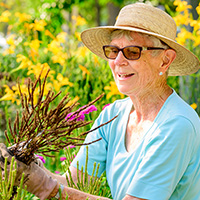
Volunteer Debbie Day pulls out dried plant matter as she tends to the gardens.
Photo by Fred Zwicky
Leslie Arvan is learning how to start plants by seed. She experimented with sunflowers and snapdragons this year. She is working in the sun, clipping dead blooms from some plants but leaving the dried-up cone flowers intact because finches like to eat the seeds.
"It's cheaper than therapy. It's very therapeutic," Arvan says to me about working in the gardens. "I like being outside. I like the companionship. Dead-heading is instant gratification. You get rid of all the brown, dead stuff and you're left with what looks good."
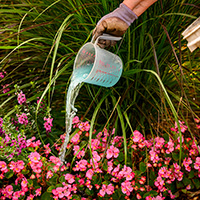
Pruning dead plants, proper watering and feeding of the plants throughout the season is essential to the gardens' beauty.
Photo by Fred Zwicky
Mary Beth Kurasek agrees that the work is calming and peaceful.
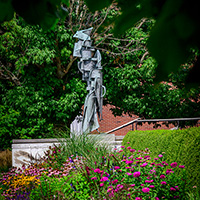
The gardens were originally designed by landscape architecture professor emeritus Terry Harkness. The space offers a peaceful place to enjoy flowers, fauna and sculpture.
Photo by Fred Zwicky
"It kind of gives you time to meditate in the sense that you are pulling weeds and it's routine and repetitious. Then you stand back after you've pulled the weeds or the dead heads and you've accomplished something," she says, taking pride in her work that will leave the plants healthier.
Rainer often notices regular visitors who come to the gardens to eat lunch when the weather is nice.
"That's the ultimate compliment," she says.






